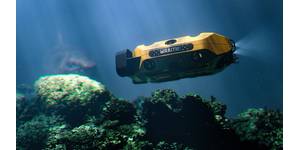Biofouling Control in Marine Instruments via UVC LEDs
By Hari Venugopalan
Biofouling is the accumulation of microorganisms, plants, algae or other organisms on wetted surfaces. The mechanism of fouling involves the initial bacterial attachment and formation of a biofilm on the surface, followed by the attachment of larger marine organisms. Biofouling affects a range of systems and components across many industries, especially those in the coastal and marine environments where the impact on optical sensors can occur within a week of deployment.
In the marine environment, biofouling affects both optical and non-optical sensors used for water quality and conductivity measurements as well as acoustic sensors (sonar) for ocean current measurement, underwater cameras, lighting, and lenses used for optical communication. In ocean monitoring, biofouling has long been considered as a limiting factor to the length of deployment for underwater instruments and sensors. The Alliance for Costal Technologies has estimated that maintenance costs due to biofouling can consume as much as 50 percent of operational budgets.
Traditional Biofouling Control Methods
There are several methods of biofouling control that have been traditionally used with limited success. Biocides have been used due to their high level of effectiveness, but they are largely being phased out due to environmental regulations. The most common biocide over the past 40 years, Tributyltin (TBT), was banned in 2008 due to its toxicity to other organisms and the environment. Other non-toxic coatings have been used to prevent biofilm, however most of them are not transparent, thus eliminating their feasibility for biofouling control in optical sensors. Mechanical options, such as wipers, have a high failure rate, relatively high power consumption, and are ineffective on complex surfaces. Other techniques, such as copper or tin plating, have been used to limit and slow organism growth but are not effective in all environments.
Controlling Biofilm
UVC irradiation offers a better method than the existing options as it is non-contact, non-chemical, and can be used across a range of instruments. Radiation in the UVC range of 250 nm -280 nm can be used to control biofouling by preventing biofilm formation. Light in these wavelengths deactivates bacteria, viruses, and other microbes by destroying the genetic information inside the DNA. By deactivating the microorganism, UV light prevents the formation of a biofilm, thereby preventing the later phases of biofouling where larger organisms attach to the instrument and render the instrument inoperable.
Although the potential of UV radiation for biofouling control has been known for some time, traditional UV lamps containing mercury are not a feasible option in many aquatic settings due to their bulk, fragility, high power consumption, and the toxic nature of mercury. These lamps are also difficult to start in cold environments. LEDs that emit UVC light offer a more suitable solution that overcomes the limitations of mercury lamps. They consume less power, have a smaller footprint for more design flexibility, and high brightness in the necessary germicidal wavelengths. Newly available high performance UVC LEDs offer greater reliability and lifetime than the early commercialized devices. This makes them suitable for long deployments in marine environments.
Simulations using UVC LEDs
Instrument manufacturers select biofouling control methods that offer optimal protection while maintaining the integrity of measurements and overall instrument design. In general, protection can be classified as volumetric, where the protection is acting in a small volume around the sensor area, or surface, where protection is directly acting on the sensing area. For example, irradiation of water in a conductivity cell to prevent microbe growth is volumetric protection while irradiation of a sensor electrode in that cell is considered surface protection.
The amount of UVC radiation needed to prevent biofilm in an application is referred to as the required UV dose. The effective UV dose is comprised of two factors—the intensity of the light and the length of exposure time. Dosage is typically measured in milli-joules per centimeter squared (mJ/cm2) and is the product of UV intensity (in mW/cm2) and the exposure time (in seconds). Industrial engineers and instrument designers use the relationship between these two parameters to develop an effective system. Figures 2 and 3 show a volumetric protection example with a required UV dose of 10 mJ/cm2. The cell has an external diameter of 10 mm and a length of 50 mm. Two UVC LEDs, each emitting 2.5 mW, are used to achieve a fairly uniform intensity throughout the volume of the water in the cell to ensure that the full volume receives sufficient UV light. As seen in Figure 3 the irradiation pattern in this example is fairly uniform. However, it is important to note that it is the minimum, not the average, irradiance the engineers must consider for appropriate protection. In this example, 0.2 mW/cm2 is the minimum irradiance of the system, so to achieve the target dose of 10 mJ/cm2 the cell requires a minimum exposure of 50 seconds.
Figure 4 shows an example of surface protection on a flat surface 10 mm x 10 mm which requires a UV dose of 40 mJ/cm2. The intensity distribution on the surface depends on the distance between the UVC LED and the surface to be irradiated, the light output of the LED, and the light emission pattern. In this example, the surface is 10 mm from the light source and the UVC LED emits 2.5 mW in a radiation pattern of 100 degrees. Another critical design parameter is the repetitive cycling required for UV irradiation. Specifically, cell division of colonized bacteria and colonization of fouling organisms happens during the intervals between UV radiation exposures. So, in addition to the calculated exposure time, designers need to consider the duty cycle for the LED as an important process parameter. Duty cycle is the percentage in one period in which an LED is turned on, for example an LED operating at a 50 percent duty cycle would be turned on exactly half of the time and off half of the time. By operating at a duty cycle the LED is periodically turned on to deactivate DNA and then turned off to minimize power consumption. The optimal duty cycle for a system is typically determined by lab testing. The small footprint and high brightness of UVC LEDs enables use in a variety of sensors, including remote monitoring in far areas of the world. By controlling biofilm growth, UVC LEDs allow manufacturers to extend the duration of in situ deployments in marine environments while reducing maintenance costs. Integrating UVC LEDs into these instruments for biofouling control is an emerging trend that will become one of the mainstays of the industry in the coming years.
The Author
Hari Venugopalan is Director of Product Management at Crystal IS. He has more than 10 years of experience in visible and UV LEDs.



 August 2025
August 2025



